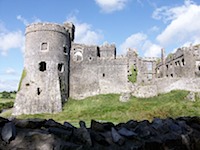A fascinating mix of architectural styles, from Norman to Elizabethan - and don't miss the bats!
Carew Castle is tucked away in a beautiful area of Pembrokeshire, not far from Pembroke itself. It's a ruin now, but what's fascinating about it, is the mixture of styles it presents. This is because it was changed over the years from a sturdy Norman castle into a flamboyant Elizabethan manor. Depending on where you stand you see either a medieval stronghold or an Elizabethan confection.
This is a superb place to take children. Although it's ruined, there are still rooms and towers to explore, and it makes a wonderful location for a game of hide and seek. When we last visited, there was a quiz sheet to fill in, looking for clues as you walked around. That's a lovely way for children to pick up information without feeling that they're being taught.
Before you go into the castle, take a look at the Celtic Cross on the right as you walk towards the castle entrance.
The original castle here was built by Gerald de Windsor and his colourful wife, Princess Nest. Nest was reputedly a very beautiful woman. She was abducted from Carew, not too unwillingly according to tradition, by Owain ap Cadwgan. She already had five children by Gerald, but had two more with Owain. After six years, Gerald recovered his wife and killed Owain, but then he died shortly after. Nest married again, having even more children!
The oldest parts of the stone building you see today were built by Sir Nicholas de Carew, one of the knights of Edward I, between 1280 and 1310, with late additions being made by Sir Rhys ap Thomas, a supporter of the future King Henry VII at the Battle Of Bosworth.
The Elizabethan alterations to the castle were the work of Sir John Perot, who may have been an illegitimate son of HenryVIII. Tragically his life ended in The Tower of London in 1592.
The Elizabethan aspects of the castle make me think very much of Kenilworth Castle in Warwickshire, although on a different scale, both show how a once formidable structure was 'modernised' in a new style. Sadly both at Carew and at Kenilworth, the men responsible for the changes came to tragic ends.








